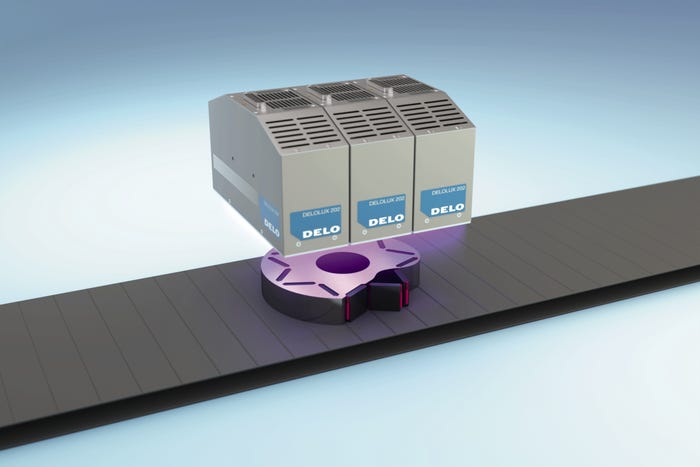Need a Light-Curing Adhesive Solution? These 5 Tips Will Help
For a better understanding of light-curing adhesives, here are five tips designed to help users.
October 22, 2021

Bernd Scholl, team leader of the Technology Department at DELO Adhesives
The use of light-curing adhesives offers a full range of benefits. One key benefit is that they help to save time during the production process. Light-curing adhesives work extremely well if at least one of the components to be bonded is either transparent or translucent. Since the joining process can be easily automated, the technology used for light curing adhesives is ideal for mass production.
To help you learn more and better understand light curing, we have come up with five tips listed below.
1. The LED lamp's wavelength must match the adhesive's absorption spectrum
Light curing of adhesives involves a photochemical reaction in which monomers combine to form a polymer when exposed to light. The reaction is triggered by a substance called photoinitiator. This substance breaks down into functional groups when exposed to light. To do this, the wavelength of the LED lamp must be matched to the photoinitiator so that the lamp's wavelength spectrum overlaps with the photoinitiator's absorption spectrum.
DELO lamps typically operate at wavelengths of 365 nm, 400 nm, or 460 nm. The lower the wavelength, the higher the emitted photo energy and the faster the adhesive cures. However, this does not mean that shorter irradiation times produce better results. Shorter wavelengths also mean lower penetration depth into the adhesive.
2. The permeability of the substrates to be bonded is an important factor
Even if wavelength and distance to the lamp have been set correctly, the adhesive may not cure – this happens when the light does not fully reach the adhesive. The substrates' permeability has a significant influence on curing time and curing degree of light-curing adhesives. Even if the materials to be joined look transparent to the human eye, they may not be permeable to light. Some materials, including polycarbonate (PC) or plexiglass (PMMA), also absorb UV light. In that case, the adhesives used should cure in the visible light range, for example at wavelengths above 380 nm.
For partially transparent components, it may help to increase the lamp's intensity for faster curing. However, in the case of slow-curing adhesives where longer irradiation times are recommended, the too high intensity may adversely affect the condition of the material. Therefore, a preliminary test of light intensity influence on both adhesive and composite quality is mandatory.

3. Pay attention not only to theoretical intensity but also to practicality
The energy required for adhesive curing is determined by the intensity and duration of the irradiation. Homogeneous irradiation of the entire surface is crucial for an optimal curing process. DELO curing lamps offer a wide range of size options, including DELOLUX 50 and DELOLUX 80 series LED spot lamps, as well as the DELOLUX 20 area lamps. All these lamp types are available with high intensities that can be continuously adjusted. This offers maximum flexibility to users who often have to deal with limited installation space in their production facilities and varying distances between the respective substrates.
4. Light curing can be used for prefixation in structural bonding processes
If structural bonds are exposed to greater static and dynamic loads or increased temperatures, heat-curing epoxy resins are usually the solution of choice. Complex fixing devices are used to keep the components in position during the curing process in the oven. This involves additional time and expense, due to the required assembly, heating, or cleaning of the fixtures.
Light-fixable products offer an alternative that can significantly shorten the production process - a two-step light and heat curing with epoxy resins. The joined components are first prefixed with light at the adhesive fillet formed at the component edges during joining. Less than one minute is required for dispensing, joining, and fixing, which is usually followed by final curing in an air convection oven or continuous oven. This method allows users not only to save on investments for fusing equipment but also a lot of time and space in production.

5. Opaque substrates can be bonded by preactivation
If opaque materials are to be bonded and there is no fillet to irradiate, light curing is impossible since the joined components have no transmittance. However, if heat curing is not desired either, preactivating the adhesive by light is an option. This takes place immediately after dispensing the adhesive. Once the adhesive is dispensed, it is exposed to light. Joining can be done immediately as the adhesive is still liquid after the short irradiation and can be formed during this open time. The adhesive then cures within a few minutes without further exposure to UV light.
You May Also Like
.jpg?width=300&auto=webp&quality=80&disable=upscale)


